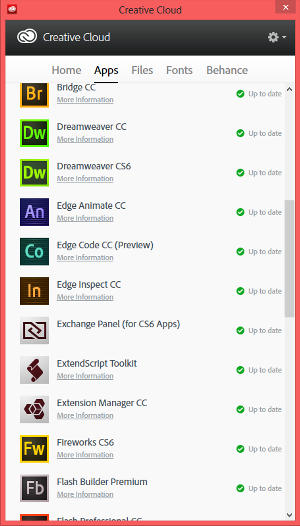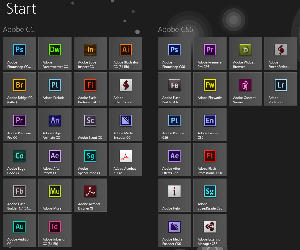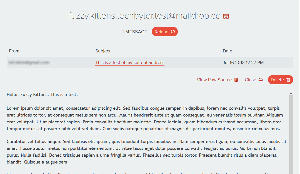Adobe Creative Cloud (First Look)
Adobe's decision to convert most of its applications (all but Lightroom) from the traditional perpetual licensing model to a rental (lease) model is one of the most disruptive changes I've seen in the 30-plus years I've spent using desktop computers. That's not to say it's bad, but it's also not to say it's good. It is, as some like to say, what it is. And we're going to see more of it.
Microsoft has already converted the Office Suite to a quasi-cloud offering, but hasn't quite has the Ballmers to go all the way. Yet. (Sorry!)
Adobe has been in the lead when it comes to dropping support for older 32-bit hardware for some applications. I didn't hear a lot of push back from professionals when it comes to hardware requirements, though. That may be because professionals understand that more efficient software that runs on faster hardware makes them more efficient. Even the pros are having some problems accepting the concept of software rental, though.
"I prefer to own my software," it a comment I've heard so many times that it no longer surprises me, but it's something that should be addressed. Even if you buy a box that contains software on a disc, you don't own the software. Really. Read the license that comes with the software. What the license bestows is your right to use the software in the manner described by the license. The software publisher still owns the software.
In that regard, the new arrangement isn't a change. What does change is the term of the license; it's no longer perpetual, but instead has a clear termination date. I've explained on previous programs how the cost structure actually saves money for those who have previously purchased every upgrade and may save money for those who have previously purchased alternate upgrades. Those who bought only every third upgrade will pay more.
Some people may adamantly refuse to accept the leasing business model and they will either continue to use CS6 (or whatever version they currently have) or they will migrate to competing products. In some cases, though, few -- if any -- competing products exist.
The Challenge for Reviewers
 In the past, a new version of an application would arrive and reviewers such as me would check out the new features and write about them. Under Creative Cloud, the situation is considerably more fluid because Adobe can introduce new features and process improvements at any time. That, in fact, might be what Adobe is counting on to convince those who are holding back to accept the new system.
In the past, a new version of an application would arrive and reviewers such as me would check out the new features and write about them. Under Creative Cloud, the situation is considerably more fluid because Adobe can introduce new features and process improvements at any time. That, in fact, might be what Adobe is counting on to convince those who are holding back to accept the new system.
But the problem for reviewers is that improvements are no longer linked explicitly to a program version.
Having worked with Creative Cloud for a while now, I'm evolving what I believe will be the process of letting you know what you'll find in the applications. Per-product summaries no longer make sense and Creative Cloud is far too large a concept with entirely too many component pieces to be reviewed in a single report. So I'm planning to talk about individual additions to specific components as I discover and evaluate them.
 So let's start with the good news about installation.
So let's start with the good news about installation.
Installing Creative Cloud
I wasn't in the office when I installed Creative Cloud. This wasn't a magic trick so much as an effort to save time. The installation, I thought, would take a considerable amount of time because all of the applications would need to be downloaded from Adobe and I knew that I could check in several times during the day to check on the process. To test, I selected a single CC application (Photoshop 64-bit) and was surprised to see how quickly it downloaded and installed.
Granted, I do have an acceptably fast (at least by US standards) broadband connection but even so the installation was complete far sooner than expected.
Based on what I had seen during the installation, I believed that the existing CS6 version of Photoshop would still be installed and fully functional. It was, and that's good news. Anyone who tries Creative Cloud and decides not to continue with it can, with relative ease, return to the previously installed perpetual license.
Next, I selected most of the CC applications for installation and logged off. When I logged on again about 2 hours later to check the installation process, it was complete and a quick review of the Start Screen confirmed that both old (CS6) and new (CC) versions were present.
Although I said that one can return to the previous version with relative ease, there is one caveat: When you open existing files with some, and possibly all, of the CC applications, the file format will be modified so that it will no longer open in the previous version of the application. The workaround, if you decide to return to the older application is to use Save As in the CC version to save a file that the older application can read.
It's likely that the backwards conversion from the current CC version to CS6 will work without much trouble, but I would be nervous about depending on that as a long-term solution.
The good news here is that anyone who wants to try CC can use it without restriction for 30 days. Your only commitment will be the time involved in downloading and installing the various components that you want to test.
One-Time Dead Drops for Non-Spies (Or is it a Cut-Out?)
If you watch spy movies or read spy novels, you're familiar with dead drops and cut-outs. If not, I'll explain what they are. Even if you're not a spy, you could have a good reason for wanting to employ these bits of spycraft. And I'll also explain how you can do that.
I'll start with a couple of descriptions, complements of Wikipedia.
- A dead drop is a method of espionage trade craft used to pass items between two individuals using a secret location and thus does not require them to meet directly. Using a dead drop permits a case officer and agent to exchange objects and information while maintaining operational security. Compare this to the live drop, which requires two people to meet when exchanging items or information.
- In espionage parlance, a cut-out is a mutually trusted intermediary, method, or channel of communication that facilitates the exchange of information between agents. Cutouts usually only know the source and destination of the information to be transmitted, but are unaware of the identities of any other persons involved in the espionage process. Thus, a captured cutout cannot be used to identify members of an espionage cell.
Based on the description, I think that what I'm about to describe is more like a cut-out than a dead drop. Although I've never worked for an intelligence agency, I know that the FBI has a file on me.* I don't know about the CIA or the NSA, but that's probably not germane to this account.
*I know this because in the 1970s I filed a request under the Freedom of Information Act to request a copy of my FBI file. It arrived some months later, heavily redacted, and with the conclusion that I was not a threat to national security.
Why Would an Honest Non-Spy Want a Cut-Out?
The most obvious reason that I can think of is this: A website demands that you provide a functioning e-mail address before you can use the site. At this point, you don't know much about the people who operate the website. You're not sure if they're ethical. You don't know whether, despite promises to the contrary, whether they will spam you. In other words, you'd like to have a casual relationship before you commit to something more formal.
You need MailDrop.cc. Let's say that the website you've visited is called Techbyter.com and you're not sure that the guy who runs it is trustworthy. After all, he's already told you that he has an FBI file. Before you trust this guy with your real e-mail address, you want to confirm that he's not a nattering nabob of negativism. (Thanks to Spiro T. [nolo contendere] Agnew for that term.)
Instead of your e-mail address, you offer an address that contains elements known only to you and something that identifies the website. Say, for example, fuzzy.kittens.techbyter.test@maildrop.cc. Give the TechByter guy that address, he can send messages to you, and you can pick them up all without ever divulging your real e-mail address.
 But wait! Won't you have to sign up with MailDrop.cc and give them your real address?
But wait! Won't you have to sign up with MailDrop.cc and give them your real address?
In a word, no. That's both the beauty and the danger of MailDrop. You can use any e-mail address you want, but you don't open an account with MailDrop. You don't have a password. Anyone who knows the address can see any messages that are sent to it, so choose the address you use carefully.
The MailDrop website explains: MailDrop has no sign-ups. MailDrop has no passwords. MailDrop is designed for no security. MailDrop is designed for little to no privacy. MailDrop offers the ability to give out a quick e-mail address to any site or app, then after you've established more trust with that site, you can give them your real e-mail address. MailDrop helps to stop your in-box from getting flooded with spam from that one time you registered on a site that got hacked. MailDrop can be used to get your receipt for your e-commerce purchase, without signing up to be spammed on a regular basis with "latest offers".
My fuzzy.kittens address is aliased to "D-26y44vp4jd5wdz8dxxb6l8gdle@maildrop.cc" and, if I use that address, I have to know the original address to be able to see what's in the mailbox. "Use an alias address when you need a little bit more security," according to the MailDrop site.
You can't use a MailDrop box for illegal activities and there are other restrictions. Plain text and HTML messages are allowed, but must be less than 100k in length. All attachments in messages are removed and discarded, so nobody can send you a file. In-boxes are limited to a maximum of 10 messages and any in-box that does not receive a message within 24 hours will be automatically cleared. Consider the 24-hour rule a maximum because any particular in-box that has not recently received a message may be cleared to make room for messages that have been sent to more active in-boxes.
Short Circuits
Microsoft Drops Surface RT Price
Perhaps taking a play from Apple's play book, Microsoft has dropped the price of its Surface RT tablet by $150. This is the process that Apple fans have come to know and hate: Early adopters pay full price while those who wait usually pay quite a bit less for additional features.
In this case, the features are the same, but the price is now $450 instead of $600 for the RT version (this is the one that won't run full Windows applications) with 32 gigabytes of memory, a 10.1-inch screen, and the touch-sensitive keyboard that also acts as a screen cover. Omit the keyboard and the price is just $350.
IDC, one of the two big research firms that works in the high-tech industry, says that Microsoft shipped about 1 million tablets during the first quarter, of which about a quarter were RT version systems. Overall, tablet sales worldwide are set at about 50 million units. Apple has nearly 40% of the market and Microsoft shares the Windows market with Acer, Amazon, Asus, and Samsung.
The Surface tablets have generally received positive reviews but they have not yet gained much of a hold on the market. Microsoft, despite its plans to become more of a devices and services company, is still not a well known name in hardware, except for keyboards, mice, and the Xbox gaming console.
SoftBank Acquires Sprint Nextel and Prices Drop
The Federal Communications Commission approved the acquisition of Sprint Nextel, the #3 US cellular telephone provider, by Japan's SoftBank. The vote by FCC commissioners was unanimous. In addition, Sprint will acquire the remaining portion of Clearwire that it doesn't currently own. The proposal had been approved previously by the Federal Trade Commission and by Sprint shareholders.
Sprint immediately lowered prices, but not by as much as many expected. T-Mobile, the 4th largest carrier, offers a $70 package for unlimited talk, text, and data. Industry-leader Verizon's unlimited plan costs $90 per month and AT&T, in second place, has an $85 unlimited plan.
Sprint's price had been the highest of the major carriers at $110, but the new price, which apparently was in planning stages before the acquisition, dropped the monthly fee to $80.
SoftBank's CEO has promised more aggressive pricing while also working to upgrade its network. The company's pricing plans in Japan have been credited with forcing an overall decline in the cost of cellular service as competitors were forced to match SoftBank's rates.
But for Sprint to be competitive in the US, the company will need to upgrade its network. SoftBank plans to spend $16 billion on that project over the next 2 years, primarily to improve its base stations.
The price is $21.6 billion for 78% of Sprint Nextel and it's the largest purchase outside of Japan ever made by a Japanese company. The money will allow Sprint to upgrade its network so that it will be more competitive with AT&T (#1) and Verizon (#2). Clearwire owns a large chunk of spectrum that Sprint will be able to leverage in competing against the larger services.
The FCC review determined that the 2 deals would be likely to improve mobile broadband access and cellular telephone service and that potentially it could result in lower prices for rural, low-income, and minority consumers.
No More Laid-Back Security at Universities
At one time, colleges and universities operated with lax security measures but that's been changing in recent years as higher-education computer systems increasingly come under attack. The attacks are staged not to damage the systems but to extract information.
An article by Richard Pérez-Peña in the New York Times reveals the challenges faced by university computer system operators: "America’s research universities, among the most open and robust centers of information exchange in the world, are increasingly coming under cyberattack, most of it thought to be from China, with millions of hacking attempts weekly. Campuses are being forced to tighten security, constrict their culture of openness and try to determine what has been stolen."
The article says that the University of Wisconsin has dealt with up to 100,000 hacking attempts from China. That's 100,000 per day! In addition, there are attacks from Russia, Viet Nam, Eastern Europe, and probably some from students on campus.
Some of the attempts have undoubtedly been successful. Others probably have not been detected. And often the problem isn't discovered until long after it happened, meaning that university researchers have virtually no chance of identifying what information, if any, has been stolen.
Pérez-Peña's article notes that university computer systems are a virtual goldmine for anyone who's seeking information on pharmaceutical research, computer development, and energy devices; it quotes Cornell Director of Information Technology Policy, Tracy Mitrano, who said that detection is difficult because "hackers' ability to detect vulnerabilities and penetrate them without being detected has increased sharply."
Educational institutions function best when information can be freely shared, but universities are now having to build increasingly sophisticated protective systems. Pérez-Peña says university IT officials "are resisting the temptation to create a fortress with high digital walls."
Read the full article on the New York Times website.
